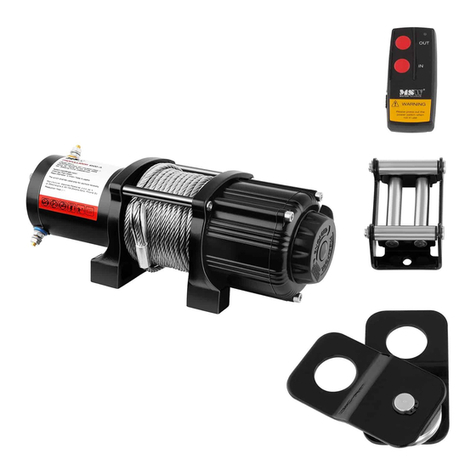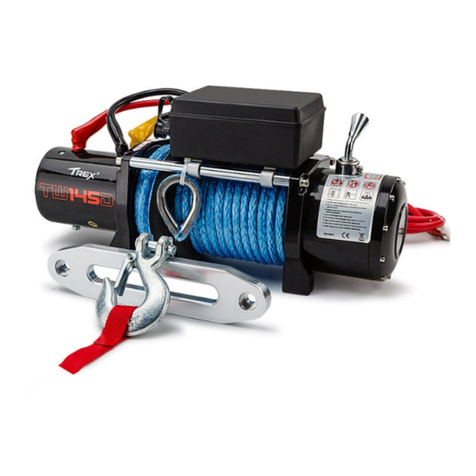Tractel Group altotir Manual

Operating and
maintenance instructions
Manual de empleo y
de mantenimiento
Istruzioni per l’uso e
la manutenzione
Instruções de uso e
de manutenção
GB
E
IT
P
altotir™
Powered drum winch
Torno eléctrico de tambor
Argano elettrico a tamburo
Guincho eléctrico de tambor
2
English
Español
italiano
Português

2
GB
CONTENTS Pages
1) Important safety information ............................................................................................ 3
2) Pictogram definitions ........................................................................................................ 4
3) Presentation
3.1 Conditions and composition of standard delivery ............................................ 4
3.2 Product definition ................................................................................... 4 and 5
3.3 Compliance with applicable regulations and standards .................................. 5
4) Description
4.1 Description of functions ................................................................................... 5
4.2 Altotir system components .............................................................................. 6
4.3 Dimensional specifications .............................................................................. 7
4.4 Functional specifications ................................................................................. 8
4.5 Electrical diagram ............................................................................................ 9
4.6 Control components ...................................................................................... 10
4.7 Safety devices ............................................................................................... 10
5) Wire rope ............................................................................................................ 10 and 11
6) Jib crane for scaffolding ................................................................................................. 11
7) Setup, installation
7.1 General checks before installation ........................................................ 11 to 13
7.2 Installation on jib crane ......................................................................... 13 to 15
7.3 Installation on frame ............................................................................. 15 to 18
7.4 Installation bearing on base tube ....................................................... 18 and 19
7.5 Commissioning .............................................................................................. 19
8) Maneuvers
8.1 Preliminary conditions ................................................................................... 19
8.2 Checks before use ........................................................................................ 19
8.3 Procedure ............................................................................................. 20 to 21
9) Emergency procedure in case of incident ...................................................................... 21
10) Unauthorized use of winch equipment ............................................................. 22 and 23
11) Malfunctions ..................................................................................................... 24 and 25
12) Temporary removal from service and deinstallation
12.1 Removal from service .................................................................................. 25
12.2 Checks before deinstallation ....................................................................... 26
12.3 Deinstallation procedure .................................................................. 26 and 27
13) Transport and Storage ................................................................................................. 27
14) Servicing, maintenance, periodic checks
14.1 Periodic checks required .................................................................... 27 to 29
14.2 Servicing, maintenance ............................................................................... 29
14.3 Spare parts ......................................................................................... 30 to 33
14.4 Inspection and maintenance sheet .............................................................. 33
15) Scrapping and protection of the environment .............................................................. 33
16) Markings on product and written instructions ............................................................... 33
Always concerned to improve the quality of its products, the TRACTEL Group reserves the right to modify
the specifications of the equipment described in this manual.
The companies of the TRACTEL Group and their agents or distributors will supply on request descriptive
documentation on the full range of TRACTEL products: lifting and pulling machines, permanent and
temporary access equipment, safety devices, electronic load indicators, accessories such as pulley blocks,
hooks, slings, ground anchors, etc… The TRACTEL network is able to supply an after-sales and regular
maintenance service.

3
GB
IMPORTANT SAFETY INFORMATION
1) Before installing and using your winch, be sure you are
perfectly familiar with the information contained in this manual;
you must comply with the utilization and safety instructions
given to ensure safe use of the winch. A copy of this manual
should be available to all winch users. Additional copies can
be provided on request.
2) Do not use the winch if any of the identication plates mounted
on the winch are damaged or illegible, or if any of the
markings, as indicated in section 16, are no longer legible. In
case of a damaged information plate, identical plates can be
supplied on request and should be fastened to the equipment
before continuing use of the equipment.
3) Make sure that any person to whom you have entrusted use
of the winch is perfectly familiar with the information contained
in this manual and is able to satisfy the safety requirements
involved by the purpose for which the equipment is used. This
manual should be in the user’s possession.
4) For all professional purposes, the winch must be placed under
the responsibility of a person who is perfectly familiar with the
applicable regulations and who has the necessary authority
to ensure application of these regulations by all users.
5) Any person using the winch for the first time must check, in a
risk-free environment, before applying the load, and on a
limited lifting height, that he has fully understood all the
requirements for safe, efficient operation of the equipment.
6) Set up and operation of the winch must only be performed
under conditions ensuring operator safety in compliance with
the regulations applicable to the equipment category.
7) Before use, systematically check that the winch and its
accessories are in good condition.
8) Tractel
®
shall not be held liable for use of the winch in any
setup configuration not described in this manual.
9) Any changes to the winch not supervised by Tractel, including
removal of parts, shall release Tractel
®
from all liability.
10) Any equipment assembly or disassembly not described in
this manual, or any repair performed without Tractel
®
authorization will release Tractel
®
from all liability, especially
where original parts are replaced by parts which are not
genuine Tractel
®
parts.
11) The winch must never be used for any operations other than
those described in this manual. It should never be used with
loads exceeding the working load limit indicated on the
winch. The winch should never be used in an explosive
atmosphere.
12) To ensure safe use of the winch, it must be inspected and
serviced regularly to ensure that it is in a good, safe
operating condition. The winch should be inspected
periodically by a Tractel-approved repair agent as indicated
in this manual.
13) When the winch is not being used, it should be kept safety
out of reach of persons not authorized to use it.
14) For definitive removal from use of the winch, it should be
scrapped under conditions preventing any future use of the
winch. All environment protection regulations must be
observed.
15) The winch must be anchored to a structure which is
sufficiently strong to withstand the working load limit
indicated in this manual. If several units are used, the
strength of the structure and of the anchor point must be
consistent with the number of winches used in accordance
with their working load limit.
16) Never stand or circulate under the load. The area located
under the load should be indicated and access to this area
should be prohibited.
17) The winch must only be used in full compliance of applicable
safety regulations and standards relative to the installation,
use, maintenance and inspection of equipment lifting
devices.
18) It is strictly prohibited to use the winch for lifting or moving
persons.
19) During the lifting operations, when moving up or down, the
operator must always have a clear, uninterrupted view of the
load.
20) Before connecting the winch to its power source, check that
the power source complies with the characteristics of the
winch and that the electrical installation satisfies all the
necessary safety regulations.
21) Tractel
®
will only guaranty operation of the winch provided it
is equipped with a genuine Tractel
®
wire rope having the
characteristics specified in this manual.
22) Any intervention on the wire rope aimed at modifying or
repairing it outside Tractel
®
supervision will release Tractel
®
from any liability subsequent to the modification or repair
performed.
23) Keeping the wire rope in good condition is essential to safety
and correct operation of the machine. The condition of the
wire rope should be checked each time it is used as
indicated in the “wire rope” section. Any wire rope showing
any signs of damage must be immediately and definitively
removed from use.
24) During use, the operator must ensure that the wire rope is
constantly tensioned by the load and, in particular, that the
wire rope is not temporarily neutralized by an obstacle when
bringing a load down, as this could result in rupture of the
cable when the load comes free from its obstacle.
25) Before use, systematically check that the high limit stop is
properly positioned and operates correctly.
26) During lifting and lowering operations, the operator must
constantly observe the maneuver and the load to prevent
any risks of snagging.
IMPORTANT:
For all professional uses, especially when the machine
is to be used by employee personnel, you must
comply with all work regulations applicable to
installation, maintenance and use of the equipment, in
particular as concerns the required inspections:
inspection on first use by user, periodic inspections,
and inspections after disassembly or repair.

4
GB
2) Pictogram definitions
In this manual, the following terms are used:
“Operator”: Person or department in charge
of management and safe use of the product
for the purpose for which it is intended.
“Installer”: Person or department in charge of
assembly of the components of the product
received, installation of the product for use,
disassembly, dismantling, and transport for
storage and shelving.
“Technician”: Qualified person who is skilled
and familiar with the product, and who is in
charge of the maintenance operations
described in this manual.
“After-sales service”:
Company or department authorized by a
company of the Tractel®group for after-sales
service or repair operations on the product.
“DANGER”: Indicates remarks inten-
ded to avoid injury to persons which may be
mortal, serious or minor.
“IMPORTANT”: Indicates remarks
intended to avoid a failure or damage to the
product, equipment or environment, but not
directly endangering the life or health of the
operator or any other persons.
“NOTE”: Indicates remarks relative
to precautions to be followed to ensure
efficient and comfortable installation, use and
maintenance, with no implication of damage
or injury.
Read the user manual. This
symbol must be present on the product, and
indicated in the “Markings” section.
Enter the information in the
inspection and maintenance sheet.
3 Presentation
3.1 Conditions and composition of
standard delivery
The altotir™ winch standard delivery
comprises:
1. A plastic bag containing: 2 clamps for
mounting on tube (Fig. 1, item 8) and
4 clamping nuts (Fig. 1, item 14).
2. A plastic bag containing a CE statement
along with this user manual.
3. The winch, comprising:
• A control unit (Fig. 1, item 16)
• A power connector (Fig. 1, item 20)
• A lifting wire rope (Fig. 1, item 1)
equipped with its lifting hook (Fig. 1,
item 2)
NOTE: Any delivery not
comprising all the items of the standard
product composition must be compared
against the order.
3.2 Product definition
3.2.1 Definition of product and
intended use
The altotir™ winch is an electric drum winch.
It is designed for vertical load lifting by an
electric motor-driven winch. The winch is
designed to be manually transportable.
The winch is usually used as follows:
• Winch mounted on scaffolding jib crane,
itself secured to scaffolding (Fig. 10)
• Mounted on frame.
Other utilization configurations are detailed in
the sections which follow:

GB
3.2.2 Operating principle
Using the two control buttons on the control
unit (Fig. 1, item 21), the operator controls
lifting and lowering of the load secured to the
lifting hook (Fig. 1, item 2). To stop an up or
down movement, the operator simply
releases the control button used.
3.2.3 Characteristics of host structure
IMPORTANT: Before using the hoist,
the operator must make sure that the
scaffolding is sufficiently strong and stable to
handle the working load limit of the winch, to
which the weight of the unit and its
accessories must be added, in compliance
with applicable rules and regulations.
3.2.4 Complementary product
required (see Section 7)
When using the altotir™ winch on scaffolding,
a scaffolding jib crane (Fig.8) is required. The
altotir™ winch must be secured on the jib
crane tube (Fig. 10, item 11) by its mounting
clamps (Fig. 10, item 8).
The assembly formed by the altotir™ winch
and the jib crane must be secured to a
vertical tube of the scaffolding using clamps
and a pivot (Fig. 8, items 3 and 4).
3.3 Compliance with applicable
regulations and standards
The altotir™ winch satisfies the requirements
of machinery directive 98/37/CE and outdoor
directive 2000/14/CE.
4 Description
4.1 Description of functions
The altotir™ winch is formed by a frame and
a geared motor assembly coupled to the wire
rope warping drum.
The frame ensures the following functions:
• Enables setting the winch on the ground in
a stable position on its base tube (Fig. 1,
item 12)
• Allows 2 persons to carry the winch by its
carrying handle (Fig. 1, item 11).
• Protects the assembly formed by the
geared motor and drum (Fig. 1, items 3, 4,
5) against projections and impacts when
installing and during use, transport and
storage of the unit.
• Ensures protection of the electrical unit
(Fig. 1, item 6) against projections, impacts
and weather when installing and during use,
transport and storage of the unit.
• Facilitates storage by its rectangular shape.
• Provides access to the electrical unit (Fig.
1, item 6) by an access plate covering the
electrical unit (Fig. 1, item 18).
• Ensures storage of the control unit (Fig. 1,
item 15) and the power connector (Fig. 1,
item 20) during transport and storage of the
unit.
• Enables securing the unit in its working
position by means of clamp fastening studs
(Fig.1, item 13) and clamp fastening cross-
members (Fig. 1, item 7).
• Enables use of the winch seated on the
ground (Fig. 12).
The geared motor ensures the following
functions:
• Lifting and lowering of a load by a single
phase electric motor (Fig. 1, item 4) driving
a reduction gear (Fig. 1, item 22), itself
driving a drum on which the wire rope winds
and unwinds.
• Enables maintaining the load in a stopped,
stationary position during an up or down
cycle by the spring-applied break.
5

6
GB
4.2 Altotir system components
The altotir™ winch is formed by the following components, shown in Fig. 1.
13
22 311 14 7
8
17
9
12
5
4
19
18
6
16
21
15
10
2
20
1
1) Lifting wire rope
2) Lifting hook
3) Wire rope warping drum.
4) Electric motor
5) Spring-applied brake
6) Electrical unit
7) Fastening crossmembers
8) Tube mounting clamps
9) Limit stop lever
10) Limit stop
11) Carrying handle
12) Base tube
13) Clamp fastening studs
14) Clamp fastening nuts.
15) Control unit.
16) Emergency stop button
17) Protective casing
18) Electrical unit access cover
19) Motor compartment access cover
20) Power connector
21) Load up-down control buttons
22) Reduction gear
The equipped wire rope is formed by the
lifting wire rope (Fig. 1, item 1), the lifting
hook (Fig. 1, item 2), and the limit stop
(Fig. 1, item 10).
The dimensions indicated on the figures in
this manual are expressed in millimeters
(mm).
NOTE: Each altotir™ winch is
tested before shipping to 110 % of its
working load limit (WLL) on a lifting height
of 1m, and to 125% of its working load limit
in static utilization mode.

4.3 Dimensional specifications
The dimensional specifications (in millimeters) of the winch are indicated in Figures 2a and
2b below.
7
GB
320
19
314
651
Ø 110
98
889
222
89
4xM10
309
Ø28
280
Figure 2a: Dimensional characteristics of winch, side view
Figure 2b: Dimensional characteristics of winch, front view

4.4 Functional specifications
The functional specifications of the winch are listed in the table below.
8
GB
Winch technical data
Winch altotir™ 200
Weight kg 49
Working load limit (WLL) kg 200
Power supply
Voltage V230 ± 12
Frequency Hz 50
Type -Single phase
Motor power kW 0.87
Startup current A11
Rated current A 8
Control voltage V230
Rated lifting speed m/min 21
Maximum working height m25
Guarantied sound power LwA dB (A) 81
Level of weighted equivalent continuous acoustic
pressure A LAeq
dB (A) 68
Level of weighted equivalent instantaneous acoustic
pressure Lp
dB (C) 85
Outline dimensions for packaging (LxlxH) mm 690 x 280 x 320
Classification mechanism per FEM -1Cm
Protection degree
Control unit -IP65
Power connector -IP44
Electric motor -IP55
Electrical unit -IP55
Length of power cable m 1
Length of control cable m 1,5
Wire rope technical data
Unit altotir™ 200
Diameter mm 4
Tensile strength kN 13
Composition -19 x 7
Treatment -Galvanized
Length m25

4.5 Electrical diagram
DANGER:
Access to the control unit, electrical unit and motor is strictly limited to qualified electricians.
The electrical diagram of the winch is given in Figure 3.
9
GB
Figure 3: Electrical diagram of winch

4.6 Control components
The winch is operated by pressing either the
“Up” or “Down” button on the control unit
(Fig. 1, item 16); The control unit must
always be held in a vertical position by which
it hangs from its control cable. Never place
the control unit in the upside-down position
(control cable down) as this could result in
erroneous maneuvers.
When the “Up” or “Down” button is released,
the movement stops.
NOTE: “Up” and “Down” is indica-
ted on the corresponding control button by
an arrow pointing in the direction of
movement controlled, with the control unit
held upright and the control cable leading
upward (Fig. 1, item 16).
4.7 Safety devices
The altotir™ winch has the following safety
devices:
• Spring-applied brake (Fig.1, item 5).
• Red emergency stop button on control unit
(Fig. 1, item 16).
• Mechanical interlocking, inhibiting simulta-
neous action of the Up and Down controls
(integrated in control unit).
• Limit stop lever on winch (Fig. 1, item 9)
which functions with the limit stop (Fig. 1,
item 10), which can either be fixed or
adjustable, to meet the installation needs.
• Safety latch on hook (Fig. 4, item 2 ).
• Electrical protection of control unit: class 2.
The emergency stop is obtained by pressing
the red emergency stop button (Fig. 1,
item 16). In order to restart the winch after an
emergency stop, the emergency stop button
must be released by turning it in the direction
of the arrows marked on the button, after you
have made sure that the emergency
condition has been eliminated.
The hook with safety latch is shown in
figure 4.
Composition :
1) Lifting hook
2) Safety latch
NOTE: The 230V single phase
motor is protected against overheating by a
temperature sensor in the winding. The
sensor inhibits operation and interrupts the
control circuit when the temperature in the
winding is not below the trigger threshold
value.
5 Wire rope
The lifting wire rope, equipped, is shown in
figure 5.
Composition :
1) Lifting wire rope
2) High locking sleeve for limit stop
3) Limit stop
4) Low locking sleeve for limit stop
5) Loop with thimble
6) Lifting hook
IMPORTANT: To ensure safe use of
the altotir™ winch, only the altotir™ wire
rope, specially designed for this winch,
should be used.
DANGER: 1. Use of the winch with
a damaged wire rope or with a wire rope
which is not appropriate for the winch
represents a major risk of accident and
failure. The wire rope must be checked
regularly on an on-going basis to ensure that
it is in good condition. Should the wire rope
show any signs of damage, such as
deformation, bending, broken wires (Fig. 6),
it should be immediately replaced. Any wire
rope for which the nominal diameter has
been reduced, due to wear, by 10%, or which
10
GB

has more than 10 broken wires along a
length of 200mm should be eliminated.
Standard ISO 4309 (Lifting devices for
suspended loads – Wire ropes – Servicing,
maintenance, installation, inspection and
removal).
• Measure as indicated (Fig. 7).
Do not expose the wire rope to temperatures
exceeding 100°C or to aggression by
mechanical or chemical agents.
At one end, the wire rope of the altotir™
winch is equipped with a hook with safety
latch mounted on a wire rope loop equipped
with a thimble and a swaged sleeve. At this
end, it is also equipped with a limit stop
located between two specific sleeves. The
other end is fastened to the drum by a wedge
socket system (Fig. 14).
Check regularly that there are no signs of
damage where the wire rope is fastened to
the drum and to the lifting hook.
If any damage is observed, immediately
replace the complete wire rope.
6 Additional accessories
Optionally, Tractel®can also supply:
• A jib crane for mounting on scaffolding
(Fig. 8).
• An adjustable limit stop (Fig. 9).
6.1 Jib crane for scaffolding
This jib crane is particularly suited for use of
the altotir™ winch with tubular scaffolding of
diameter 49mm.
The jib crane is secured to a vertical tube of
the scaffolding and the altotir™ winch is
anchored to the anchoring tube (Fig. 8,
item 11).
The jib crane for scaffolding is shown in
figure 8.
Composition:
1) Male pivot clamp fastening nuts
2) Washers under male pivot clamp
fastening nuts
3) Male pivot clamp
4) Male pivot
5) Washer enabling sliding of female pivot
on male pivot
6) Locking pin securing male pivot on
female pivot
7) Locking screw securing male pivot and
clamp on scaffolding tube
8) Jib crane
9) Female pivot
10) Nut and locknut for adjustment and
locking of female pivot on jib crane
11) Anchoring tube
6.2 Adjustable limit stop
The adjustable limit stop is specially
designed to limit the load lifting height.
The adjustable limit stop is shown in
Figure 9.
Composition:
1) Adjustable limit stop plate
2) Wire rope clamp
3) Clamping screw
4) Hex key to tighten screws
7 Setup, installation
7.1 General checks before installation
These checks are applicable to all the winch
utilization configurations described in this
manual.
7.1.1 Host structure checks
• The mechanical strength of the host
structure to which the altotir™ winch will
be anchored, and the strength of the
pulleys, must be compatible with the
WLL of the winch, with its own weight
added.
11
GB

12
GB
7.1.2 Environment checks
Before installing, check that:
• The electrical power source is
compatible with the altotir™ winch (230
V / 50 Hz single phase) ; refer to the
nameplate and technical data table for
the altotir™ winch.
• The electrical power source is protected
in compliance with the applicable
regulations by a differential circuit-
breaker and a ground link, protecting the
operator, the altotir™ winch and its
equipment.
• The length of the electrical control cable
is sufficient to connect the winch in the
location defined by the operator under
satisfactory safety conditions.
• The operator has uninterrupted eye
contact on the equipment load along the
entire lifting height.
• The work area is secured in compliance
with applicable regulations.
• The installer has the necessary fastening
(slings) and lifting means to safely
position the altotir™ winch next to the
opening of the seating plane (Fig. 12,
item 2).
• The anchoring point for installation lifting
device is compatible with the weight of
the altotir™ winch, in compliance with
the applicable regulations.
• The location for lifting or setting the
equipment loads to be handled by the
altotir™ winch are compatible as
concerns access, strength, horizontality,
and adhesion of loads considered.
• There are no obstacles against which the
load or wire rope may bear or rub
laterally, or against which the load may
snag.
7.1.3 Winch check
Before installing, you must check that:
• The altotir™ winch is compliant with the
standard delivery as detained in this
manual.
• The length of the wire rope is sufficient
for the path to be covered by the load.
Add an additional 1 m to ensure two
remaining windings on the drum when
the load is in the lowered position.
• All of the safety systems on the altotir™
winch operate (see § 4.7).
• The wire rope passes through the
opening provided on the limit stop lever.
If not, proceed as follows:
- Switch off the winch and disconnect the
electrical power supply
- Insert the lifting hook (Fig. 1 item 2)
through the opening provided on the limit
stop lever (Fig. 1, item 9).
- Place the limit stop in a skewed position
in order to insert it in the opening
provided on the limit stop lever.
• If an extension cord is used for the electrical
power supply, it must have the following
technical characteristics:
• 230 V single phase: 3 wires (1 phase,
1 neutral, 1 ground) with section of
2.5 mm².
These characteristics are valid up to 50 m
of electrical cable. Beyond this length,
contact the Tractel®network.
• The connection of the electrical
extension cord is reinforced by an
accessory (“sleeve”) so that the
connectors do not have to support the
weight of the extension cord.
• If an electric power generator is used as
power source, that it delivers, at the
least, the voltage and power required for
startup, i.e. 6 kVA.
IMPORTANT: It is prohibited to use
the winch for pulling, slanted lifting, pulling
along a slanted plane or any other
configuration other than those described in
this manual.
DANGER: If the winch is to be
installed in a location which is dangerous for
the operator, all safety precautions required
by the applicable work regulations must be
taken to eliminate any uncontrolled hazard
during the operation.

• Check that:
- The installation conditions have been
carefully analyzed to limit, to the
maximum, any risk of falling of a person,
the equipment used or the winch.
- The operator can safely access the
altotir™ winch control unit under safety
conditions compliant with applicable
regulations.
- The installer has all the necessary
personal protection equipment (fall-
arrest harness, gloves, safety shoes,
helmet) to safely carry out the
installation.
- If the installer is required to use a fall-
arrest system as defined by directive
89/656/CEE, he must check that the
anchor point to which the fall arrest
system is anchored is sufficiently strong.
- The environment in which the winch is
used is not explosive (ATEX Directive).
- The environment in which the winch is
used is not abnormally corrosive, such
as a marine environment or other.
IMPORTANT: The load must be
secured to the wire rope by the hook.
The load must be secured by a sling of
appropriate capacity, dimensions and type
for the object to be handled (Fig.18).
The winch wire rope must not be used, under
any circumstances, as a sling by running it
around an object with the hook attached to
the wire rope (Fig.17).
7.2 Installation on jib crane
This is the most frequently used installation
configuration (Fig. 10).
For this installation, the installer must have:
• 1 altotir™ winch, standard delivery.
• 1 jib crane, with mechanical strength
verified by a qualified technician to
ensure it can handle the forces to be
applied.
7.2.1 Checks before installation
7.2.1.1 Host structure checks
IMPORTANT:
Before installing, you must check that:
• The scaffolding is sufficiently stable and
strong for use with the altotir™ winch.
• The scaffolding tube (Fig. 10, item 24) is
sufficiently strong. In particular, the
scaffolding tube must be made of steel
and have a diameter of 49 to 50 mm.
It must not show any apparent deterio-
ration such as corrosion, bending,
cracks, rupture or impact marks.
7.2.1.2 Environment checks
• Perform the general checks detailed in
section 7.1.2.
Check the following:
• Check that the assembly formed by the
jib crane and the altotir™ winch will not
interfere with any obstacle along the
entire angular working range of the jib
crane.
• Check that the operator can safety
access the jib crane to pivot it along the
necessary working range under safety
conditions satisfying the applicable
regulations.
7.2.1.3 Winch check
Perform the general checks detailed in
section 7.1.3 and check that the jib crane
complies with the standard delivery as
described in this manual.
13
GB

14
GB
7.2.2 Assembly of jib crane on
altotir™ winch and installation
on scaffolding
The altotir™ winch, equipped with the jib
crane, is shown in figure 10.
Composition:
7) Fastening crossmembers
8) Tube mounting clamps
11) Anchoring tube
13) Clamp fastening studs
14) Clamp fastening nut
24) Cylindrical scaffolding tube.
Proceed as follows when securing the
altotir™ winch on a jib crane:
Tools required:
• 1 open end wrench, 17 mm
• 1 open end wrench, 19 mm
The installation procedure comprises
3 phases:
Phase 1: Assembling the altotir™ winch and
the jib crane (Fig. 10).
• Position the anchoring tube (Fig. 10,
item 11) of the jib crane in the slots
provided for this purpose on the
fastening crossmember (Fig. 10 , item 7).
• Fit the mounting clamps (Fig. 10, item 8)
on the studs (Fig. 10, item 13).
• Manually screw on the 4 clamp fastening
nuts (Fig. 10, item 14) uniformly.
• Using the 17mm open end wrench,
moderately tighten the 4 nuts.
• Check that the mounting clamps (Fig. 10,
item 8 ) and the fastening crossmember
(Fig. 10, item7) are in contact with the
anchoring tube of the jib crane (Fig. 10,
item 11).
• Check that the jib crane is rigidly secured
to the altotir™ winch.
Phase 2: Installing the jib crane pivot on the
scaffolding tube.
• Couple the male pivot clamps (Fig. 8,
item 3) with the male pivots (Fig. 8,
item 4) using the screws, nuts and
washers (Fig. 8, items 7, 1, 2).
• Place the assembly formed by the male
pivot on the scaffolding tube (Fig. 10,
item 24); if necessary, slightly loosen the
clamp mounting nuts to facilitate
installation.
• Close the male pivot clamp (Fig. 8,
item 3) on the scaffolding tube then
manually tighten the mounting nuts (Fig.
8, item 1) symmetrically on each pivot.
• Before you lock the mounting nuts using
the 19 mm open end wrench, check that
the distance between pivots is 320 +/-
1 mm (Figure 2b) and that the pivots are
positioned in line with each other.
• Firmly lock the pivot clamp fastening nuts
using the 19 mm open end wrench.
Phase 3: Installing the altotir™ winch equip-
ped with the jib crane on the
scaffolding
• Position the jib crane equipped with the
altotir™ winch on the male pivots as
shown in figure 8.
• Using the 19 mm open end wrench,
horizontally adjust the anchoring tube
(Fig. 8, item 11) by tightening or
loosening the adjustment locknut (Fig. 8,
item 10). Once the jib crane tube is
horizontal, lock the pivot by tightening
the locknut (Fig. 8, item 10 ).
• Check that the assembly formed by the
altotir™ winch and the jib crane pivots
with no sticking points or grabbing over
the pivot working range.
• Connect the altotir™ winch to the
electrical power supply.

GB
15
7.2.3 Checks after installation
7.2.3.1 Checks without load
After completing the installation, check that:
• The winch is correctly connected
electrically.
• The electric power cable and the control
cable are not subject to any pulling or to
any risk of grabbing when the jib crane is
rotated along its travel range.
• The winch control unit is within arm’s
reach of the operator over the jib crane’s
entire travel range.
• The operator can manually pivot the jib
crane.
• The jib crane pivots with no sticking
points or grabbing over the entire
working travel.
• No interference is observed between the
wire rope, equipped with its hook and its
limit stop, and the environment over the
entire load lifting length.
• There remains at least 2 wire rope coils
on the drum when the wire rope is fully
extended to the low limit stop.
7.2.3.2 Checks with load
• Secure the maximum working load to the
lifting hook (Fig. 1, item 2).
• When the load lifts off the ground, check
that:
- The scaffolding remains stable.
If not, immediately stop the up
movement, remove the load, and take
the necessary steps to stabilize the
scaffolding.
- There is no deformation, cracks or
rupture on the scaffolding tube (Fig.10,
item 24) or in the immediate
environment.
If any problem is observed, immediately
stop the up movement and dismantle
the altotir™ winch.
- There is no slippage between the pivots
(Fig. 8, items 3 and 4) and the scaffol-
ding tube (Fig. 10, item 24).
If slippage is observed, immediately stop
the up movement, remove the load, and
re-tighten the nuts (Fig. 8, item 1) using
the 19 mm open end wrench.
- No interference is observed between the
load and the environment over the entire
load lifting height, using the control unit.
- The jib crane with load in the up position
pivots with no excess effort required on
the part of the operator.
- When pivoting the jib crane along its
travel range, no rotation slippage occurs
between the pivots (Fig. 8, items 3 and
4) and the scaffolding tube (Fig. 10,
item 24)
If slippage is observed, immediately stop
the jib crane rotation, lower the load to
the ground, reposition the pivot and
properly tighten them on the scaffolding
tube.
- No deformation on the ground or on the
working platform is observed when the
load is set down.
7.3 Installation on frame
This installation configuration is used when
the lost height of the winch is not compatible
with the lifting height (Fig. 11). For this
installation, the installer must have:
• 1 altotir™ winch, standard delivery,
• 1 adjustable limit stop (Fig. 9),
• 2 idler pulleys,
• 1 tubular anchoring structure with
diameter of 49 to 50 mm (Fig. 11) and
whose mechanical strength has been
verified by a qualified technician
For this installation configuration, the winch
is turned over; the mounting clamps, for
mounting on tube, are under the winch and
the lifting wire rope comes out toward the top
in the direction of the pulley located directly
in line with the winch.

7.3.1 Checks before installation
7.3.1.1 Host structure checks
IMPORTANT:
Before installing, check that:
• The altotir™ winch anchoring tube
(Fig. 11, item 2), is sufficiently strong. In
particular, the anchoring tube must be
made of steel and have a diameter of 49
to 50 mm. It must not show any visible
signs of corrosion, bending, cracks,
rupture or impact marks.
• The host structure next to the idler pulley
rigging (Fig. 11, items 4 and 5) complies
with the applicable regulations as
concerns stability and mechanical
strength.
• The working load limit of the idler pulleys
is compatible with the installation
configuration and the working load limit
of the winch (Fig. 11, items 4 and 5)
in compliance with the applicable regu-
lations.
• The idler pulleys are compatible with the
diameter of the winch wire rope in
compliance with the applicable regu-
lations.
• The idler pulley anchoring point, winch
side (Fig. 11, item 4) is properly situated
in line with the warping drum of the
altotir™ winch (Fig. 1, item 3).
7.3.1.2 Environment checks
Before conducting any installation, perform
the general checks detailed in section 7.1.2.
7.3.1.3 Winch checks
• Perform the general checks detailed in
section 7.1.3.
• Check that the adjustable limit stop
complies with the standard delivery
characteristics as described in this
manual.
7.3.2 Installing the altotir™ winch
Tools required:
• 1 open end wrench, 17 mm
• One hex key, 8 mm
The installation procedure comprises 3
phases:
Phase 1: Assembling the altotir™ winch on
the frame (Fig.11).
• Position the anchoring tube (Fig.11,
item 2) of the frame in the slots provided
for this purpose on the fastening
crossmember (Fig.10, item 7).
• Fit the clamps (Fig.10, item 8) on the
studs (Fig.10, item 13).
• Manually tighten the 4 clamp fastening
nuts (Fig.10, item 14) uniformly.
• Using the 17 mm open end wrench,
moderately tighten the 4 nuts.
• Check that the mounting clamps (Fig.10,
item 8) and the fastening crossmember
(Fig. 10, item 7) are in contact with the
frame anchoring tube (Fig.11, item 2).
• Check that the altotir™ winch cannot
pivot around the frame anchoring tube.
Phase 2: Installing the wire rope in pulleys
• Using the control unit, unwind the wire
rope, keeping it tensioned while
unwinding. Insert the wire rope in the
idler pulley, winch side (Fig. 11, item 4).
Using the control unit, unwind the wire
rope again, keeping the wire rope
tensioned. Insert the wire rope in the
idler pulley, load side (Fig. 11, item 5).
NOTE: Tractel®recommendation:
Two persons required when installing wire
rope on pulleys.
• Allow the lifting hook and the limit stop
to hang (Fig. 1, items 2 and 10).
• Lower the assembly formed by the lifting
hook and limit stop (Fig. 1, items 2
and 10) by acting on the control unit.
• At the end of the wire rope travel, check
that two coils of wire rope remain on the
winch warping drum.
16
GB

Phase 3: Installing the adjustable limit stop
IMPORTANT: The adjustable limit
stop must be installed on the section of lifting
wire rope located between the altotir™ winch
and the idler pulley, winch side (Fig. 11,
item 4).
• Install the adjustable limit stop as
detailed in the procedure given in
section. 14.3
• Position the adjustable limit stop to
ensure that:
• When the lifting hook is at the low limit,
the adjustable limit stop (Fig. 11, item 6)
does not interfere with the idler pulley,
winch side (Fig. 11, item 4).
• When the adjustable limit stop is in
contact with the limit stop lever (Fig. 11,
item 9), the limit stop (Fig. 11, item 10)
does not interfere with the idler pulley,
load side (Fig. 11, item 5).
• Manually check that the adjustable limit
stop is locked on the wire rope.
7.3.3 Checks after installation
7.3.3.1 Checks without load
Check that:
• There is no interference between the
adjustable limit stop (Fig. 11, item 6) and
the idler pulley, winch side (Fig.11,
item 4) when the lifting hook is at the low
limit.
• There is no interference between the
limit stop (Fig. 11, item 10) and the idler
pulley, load side (Fig. 11, item 5) when
the limit stop lever (Fig. 11, item 9) is
actuated by the adjustable limit stop
(Fig. 11, item 6).
• No interference is observed between the
wire rope, equipped with its hook and
limit stop, and the environment along the
entire load lifting height.
• No interference is observed between
the wire rope equipped with its
adjustable limit stop, and the environ-
ment along the entire load lifting height.
• The winch stops, on an up-movement
cycle, when the adjustable limit stop
(Fig. 11, item 6) comes into contact with
the limit stop lever (Fig. 11, item 9).
If this is not the case, immediately stop the
up-movement and have the limit stop lever
checked by a qualified technician.
• There are at least two coils of wire rope
remaining in the warping drum at the low
unwinding limit.
• No slack wire rope is observed while the
lifting hook is being lowered, in particular
between the 2 idler pulleys. If any slack
wire rope is observed, fit a weight on the
lifting hook to ensure that the wire rope
remains tensioned (2 kg max.).
7.3.3.2 Checks with load
• Fasten the maximum working load to the
lifting hook (Fig. 1, item 2).
• When the load lifts off the ground, check
that:
- There are no signs of deformation,
cracks or rupture on the anchoring tube
(Fig. 11, item 2) or in the immediate
environment.
If any problem is observed, immediately
stop the up-movement, remove the
weight on the ground, and have the
installation checked by a qualified
technician.
- There are no signs of deformation,
cracks or rupture next to the idler pulley
rigging point (Fig. 11, items 4 and 5) or in
the immediate environment.
If any problem is observed, immediately
stop the up-movement, set the load on
the ground and have the idler pulley
rigging point checked by a qualified
technician.
- No interference is observed between the
load and the environment along the
entire load lifting height, by acting on the
control unit.
- No deformation on the ground or on the
working platform is observed when the
load is set down.
17
GB

The inverted assembly configuration on
structure is shown in figure 11.
Composition:
1) Wire rope
2) Anchoring tube
3) Host structure
4) Idler pulley, winch side.
5) Idler pulley, load side
6) Adjustable limit stop
9) Limit stop lever
10) Limit stop.
7.4 Installation bearing on base tube
This installation configuration is used when
the installer does not have an anchoring point
for the idler pulley under the structure. For
this installation, the installer must have a
standard altotir™ winch.
7.4.1 Checks before installation
7.4.1.1 Host structure checks
IMPORTANT:
Before installing, you must check that:
• The seating plane for the altotir™ winch
(Fig.12, item 2), is sufficiently strong.
• The seating plane for the altotir™ winch
is horizontal and smooth.
• The wire rope opening under the altotir™
winch observes the dimensions require-
ments specified in Figure 12.
• The winch is properly wedged on the
seating plane to avoid any movements of
the winch when operating.
7.4.1.2 Environment checks
Before installing, perform the general checks
detailed in section 7.1.2.
7.4.1.3 Winch checks
Before installing, perform the general checks
detailed in section 7.1.3.
7.4.2 Installing the altotir™ winch
Proceed as detailed below for installation of
the altotir™ winch on the base tube.
No special tools are required.
• Run the wire rope, equipped with hook
and limit stop, through the opening
provided for passage of the wire rope.
• Position the altotir™ winch next to the
wire rope opening, observing the
positioning recommendations specified
in Figure 12.
• Wedge the winch so that it does not
move when operating.
7.4.3 Checks after installation
7.4.3.1 Checks with no load
After installing, check that:
• No interference is observed between the
wire rope, equipped with its hook and
limit stop, and the environment along the
entire load lifting height.
• The winch stops during the up-
movement when the limit stop (Fig. 12,
item 10) comes into contact with the limit
stop lever (Fig. 12, item 9).
If this is not the case, immediately stop
the up-movement and have the limit stop
lever checked by a qualified technician.
• There are at least two coils of wire rope
remaining on the warping drum at the
low unwinding limit.
• The electrical connection has been
correctly made.
18
GB

7.4.3.2 Checks with load
• Fasten the maximum working load to the
lifting hook (Fig. 1, item 2).
IMPORTANT: The load must be
secured to the wire rope by the hook.
The load must be secured by a sling of
appropriate capacity, dimensions and type
for the object to be handled. The winch wire
rope must not be used, under any
circumstances, as a sling by running it
around an object with the hook attached to
the wire rope (Figs. 17 and 18).
When the load lifts off the ground, check that:
• There are no signs of deformation,
cracks or rupture on the seating plane
next to the base tube (Fig. 12, item 2) or
in the immediate environment.
If any problem is observed, immediately
stop the up-movement, set the load on
the ground and have the installation
checked by a qualified technician.
• No interference is observed between the
load and the environment along the
entire lifting height, by acting on the
control unit.
• No deformation on the ground or on
the working platform is observed when
the load is set down.
• The winch does not move on its seating
plane.
The dimensional specifications of the
opening to be provided in the platform are
indicated in Figure 12.
7.5 Commissioning
General checks
Check that:
• The load to be lifted is less than or equal
to the WLL of the altotir™ winch.
• The lifting wire rope is in good condition.
• The safety systems are placed correctly.
• The working area is secured in com-
pliance with the applicable regulations.
Additional checks when using idler pulleys.
Check that:
• The rotation axis of the pulleys is
perpendicular to the wire rope plane.
• The adjustable limit stop is in place on
the wire rope.
8 Maneuvers
8.1 Preliminary conditions
Before performing any maneuvers with the
altotir™ winch, the operator must ensure
that:
- The lighting conditions are satisfactory
along the entire load lifting height.
- The wind speed is compatible with use
of the winch (< 50km/h).
- The climatic conditions are compatible
with the winch operating specifications
(section 4.4).
- The load to be lifted is an equipment
load and not a person.
8.2 Checks before use
Before using the altotir™ winch, the operator
must ensure that:
• The control unit does not show any
visible damage.
• The load to be lifted is less than or equal
to the WLL of the altotir™ winch.
• On the entire lifting height, there is no
risk of interference of the wire rope or of
the limit stops with an obstacle.
• The wire rope is in good condition along
its entire length.
• The control and power cables are not
damaged.
• The safety systems operate correctly.
• The work area is secured in compliance
with applicable regulations.
Additional checks according to installation
configuration:
If the winch is used on a jib crane, check that:
• The jib crane pivots freely along the
working travel range planned.
19
GB

• The fasteners securing the winch on the
jib crane, and the jib crane on the
scaffolding anchoring tube do not show
any abnormal play or damage such as
impact marks, rupture or cracks.
If the winch is used on a frame, check that:
• The rotation axis of the pulleys is
perpendicular to the wire rope plane.
• The adjustable limit stop is in place on
the wire rope.
• The fasteners securing the winch on the
frame anchoring tube do not show any
signs of abnormal play or damage such
as impact marks, rupture or cracks.
If the winch is installed bearing on the base
tube, check that:
• The altotir™ winch is correctly
positioned above the wire rope hole and
the wedging is still in place.
• The seating plane of the altotir™
winch does not show any abnormal
deformation.
8.3 Procedure
8.3.1 General
DANGER:
• The sound environment of the operator
working area must be such that
instructions exchanged during the
maneuvering procedures described in
this section can be clearly understood.
• It is prohibited to take position or to work
under the load being lifted. A prohibited
access area should be defined and
marked out under the load.
8.3.2 Lifting a load
NOTE: Tractel®recommendation:
2 operators required for winch maneuvers.
The first operator is in charge of slinging the
load.
The second operator is in charge of
operating the control unit and setting down
the load in the high position.
Description of winch maneuvering phases
when lifting a load:
• Sling the load
The operator fastens the load to be lifted to
the winch lifting hook (Fig.1, item 2).
IMPORTANT: It is strictly prohibited
to use the lifting wire rope as a sling (Fig. 17).
• Lifting the load off the ground.
By successively and momentarily pressing
the up button on the control unit (Fig. 1,
item 21), the operator lifts the load off the
ground, making sure that no part of the load
may come off during the lifting operation.
• Lifting the load
By pressing and holding the up button on the
control unit (Fig. 1, item 21), the operator lifts
the load.
DANGER: The operator must have
uninterrupted eye contact with the load
throughout the lifting height, in particular, he
must:
- Keep the load from swinging or turning.
- Keep all obstacles at a distance from the
wire rope and load.
- Avoid any slack wire rope on the strand
loaded.
• Stop lifting the load.
The operator releases the up button on the
control unit. At this moment, the operator
must check that the load has actually
stopped.
• Align and set load down in high position.
- If the winch is used on a jib crane:
The operator grabs the carrying handle
(Fig.1, item 11) and pivots the jib crane in
order to place the load vertically above the
location where it will be set down.
The operator sets down the load by acting on
the down button on the control unit.
- If the winch is used on a frame or bearing
on the base tube:
20
GB
Table of contents
Other Tractel Group Winch manuals
Popular Winch manuals by other brands

Badland
Badland ZXR 2500 user manual
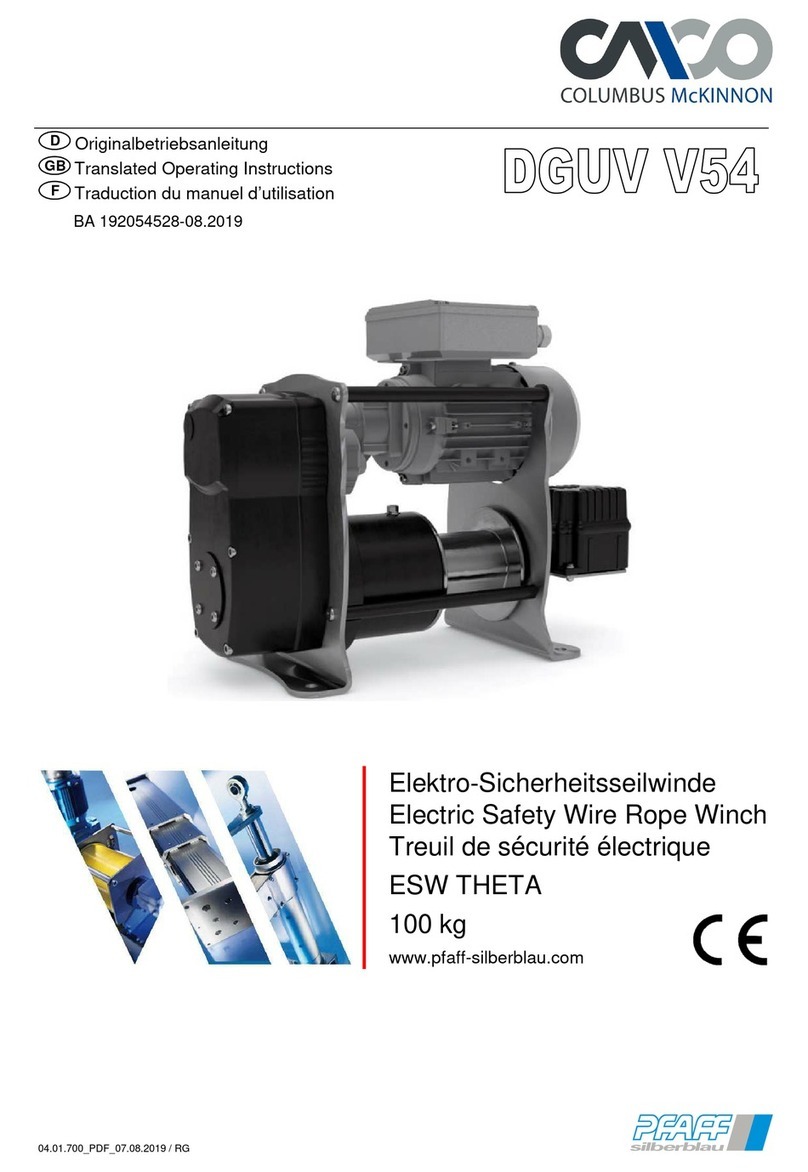
Columbus McKinnon
Columbus McKinnon DGUV V54 operating instructions
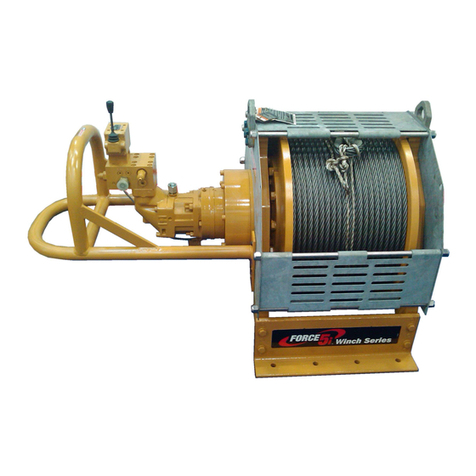
Ingersoll-Rand
Ingersoll-Rand Force 5 FH5 Parts, operation and maintenance manual
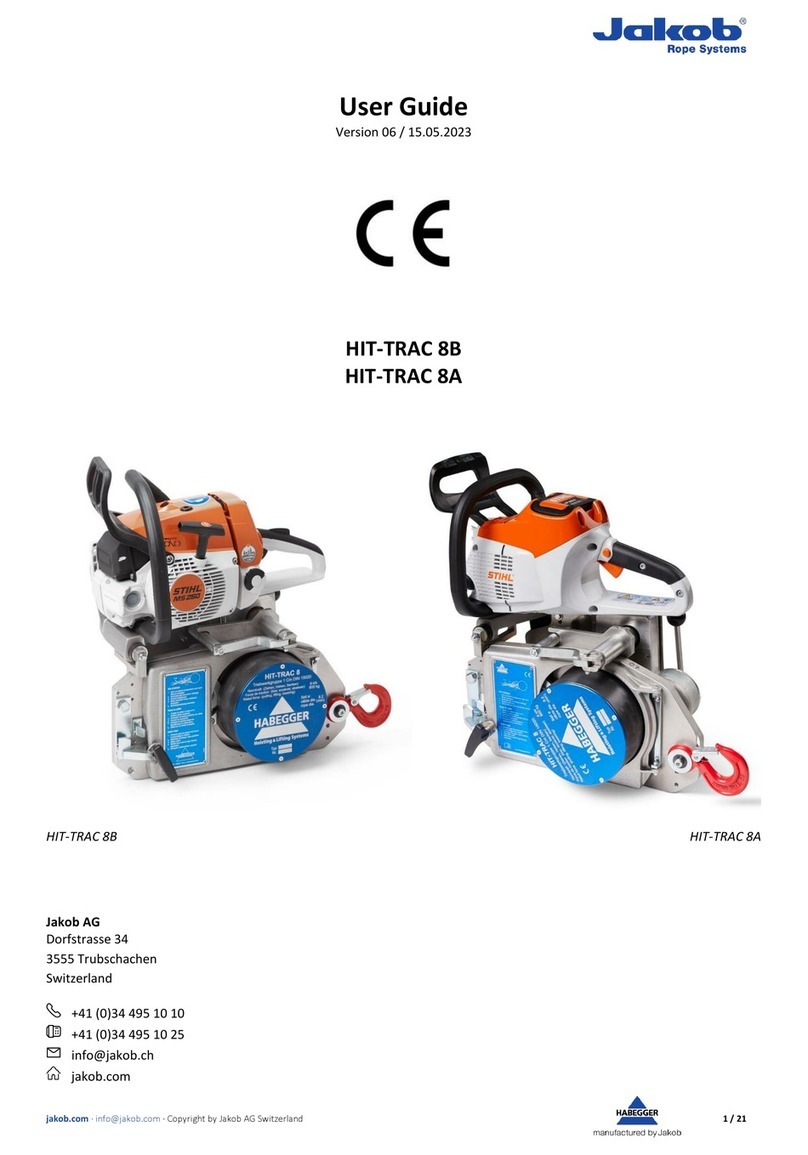
jakob
jakob HIT-TRAC 8B user guide
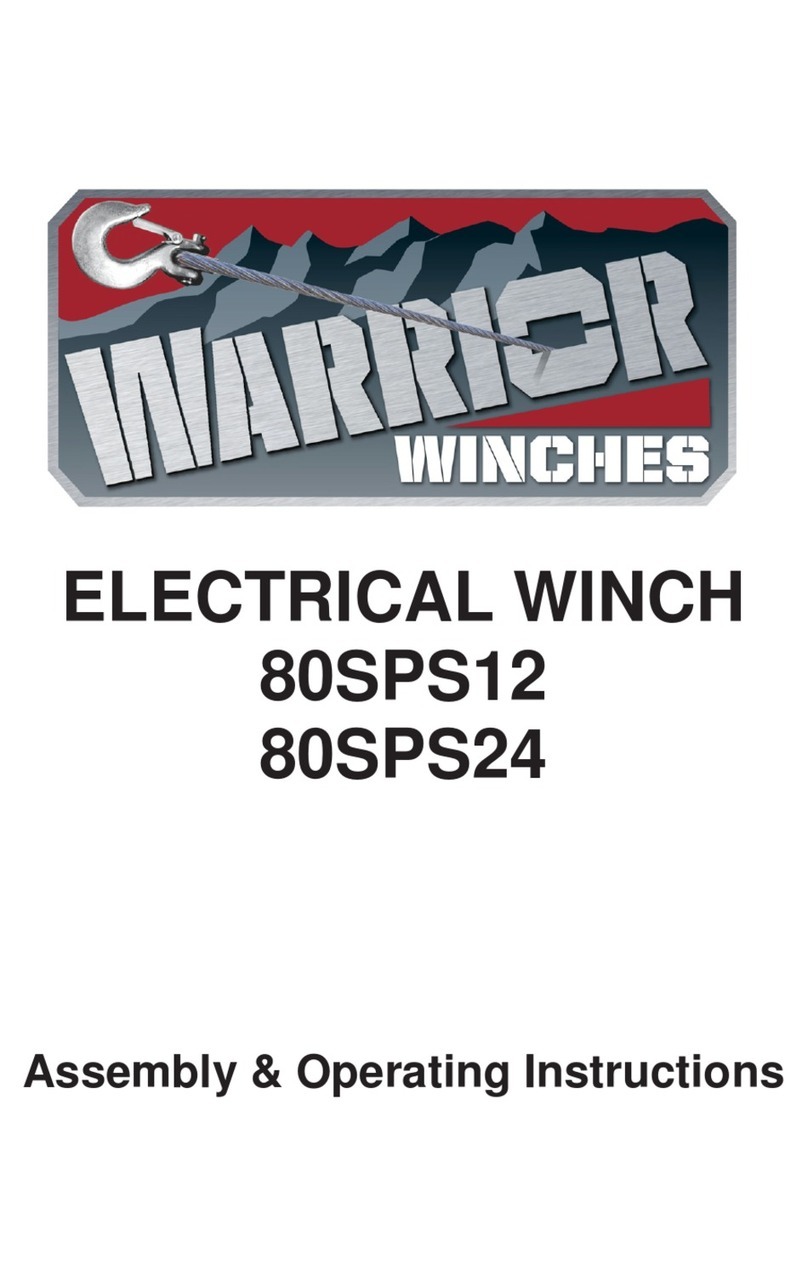
Warrior Winches
Warrior Winches 80SPS12 Assembly & operating instructions
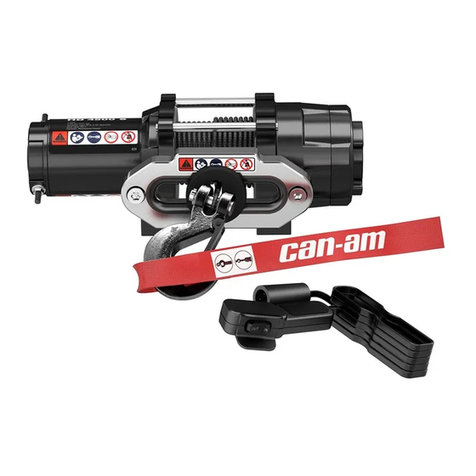
BRP
BRP Can-Am HD 4500 2020 Operator's guide

Harken
Harken 16.2 Two Speed Winch Installation service
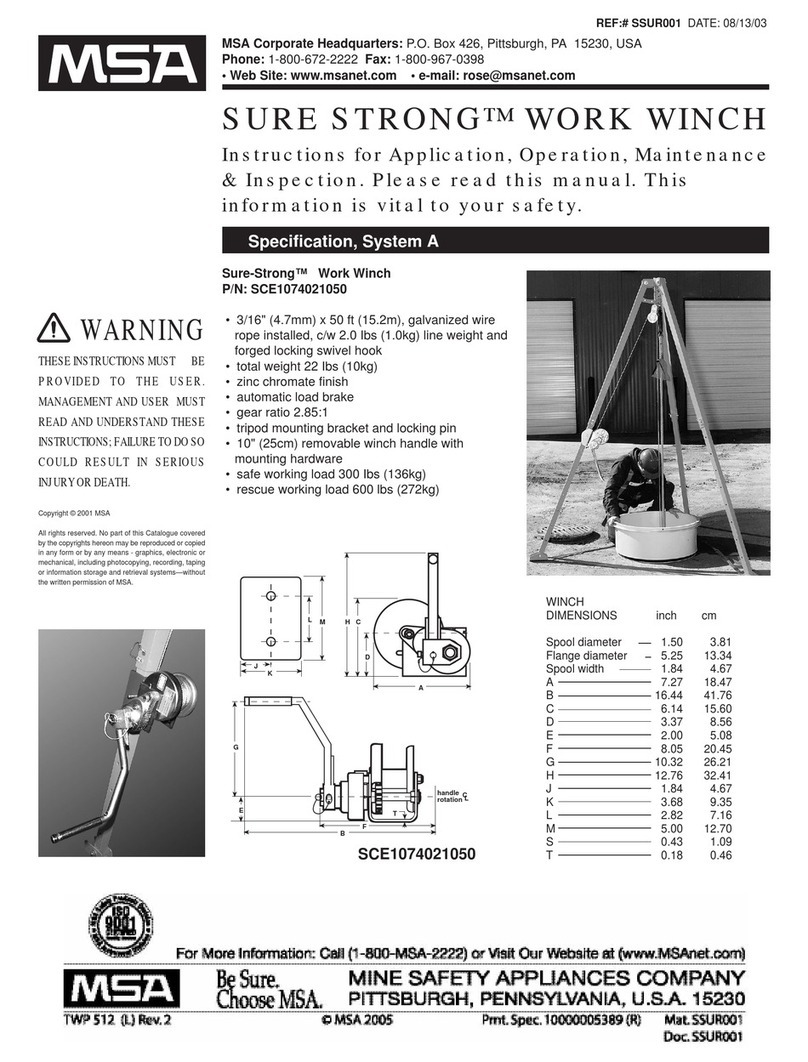
MSA
MSA SURE STRONG SCE1074021050 Instruction for operation and maintenance

Lewmar
Lewmar 5CT quick start guide
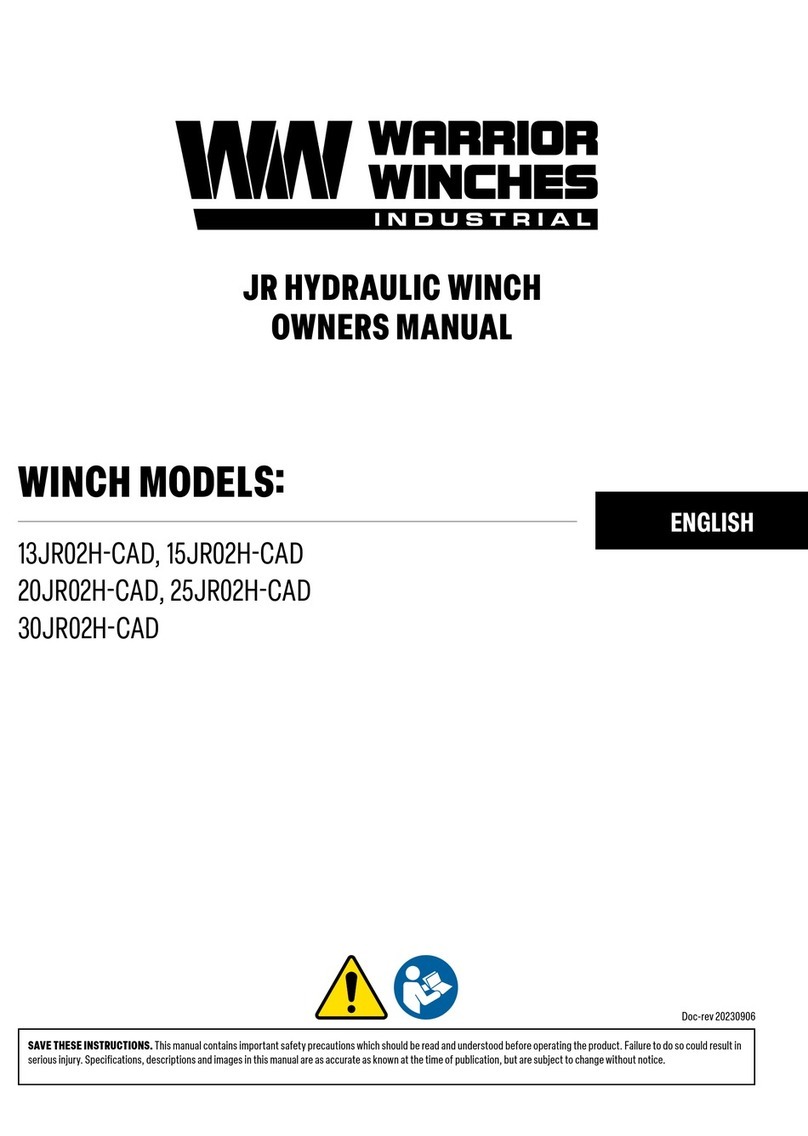
Warrior Winches
Warrior Winches 13JR02H-CAD owner's manual
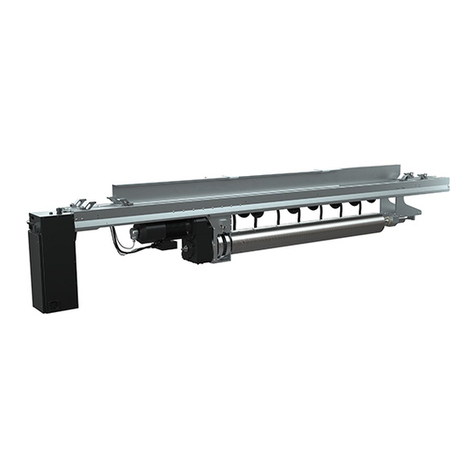
ETC
ETC Vortek NXT User's operation manual

Huchez
Huchez MANIBOX VS Series instruction manual

